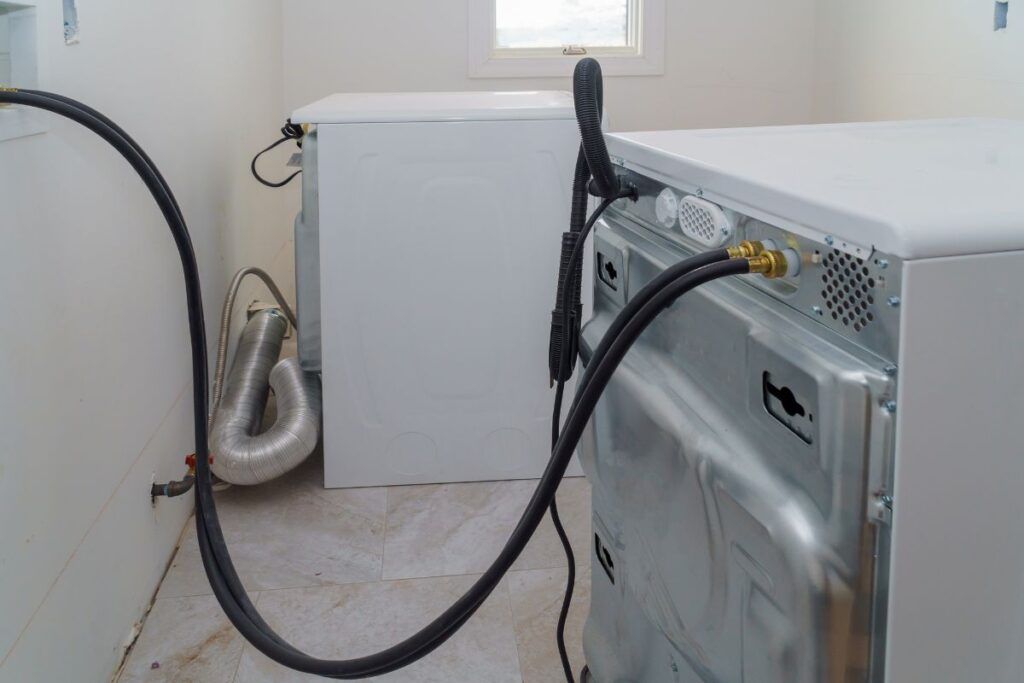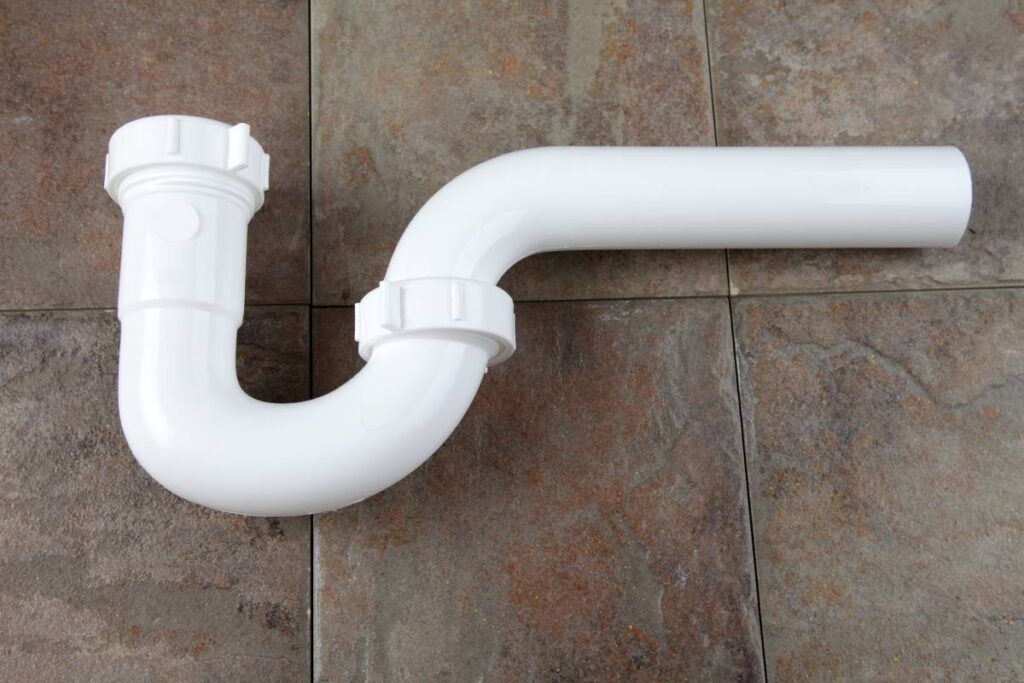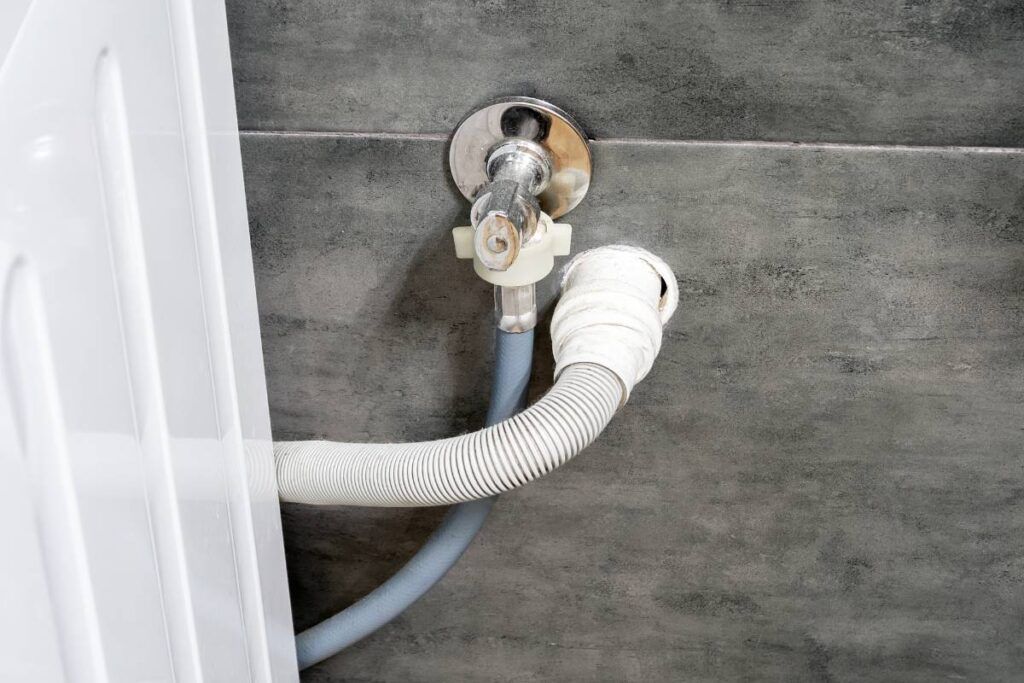Draining is the last yet significant function of a washing machine. If you are installing the washing machine unit in your new house and are unsure what the ideal drain size is, you are at the right place.
Ideally, the drain pipe should have a diameter of 1 1/2 inches to 2 inches and must be 25-35 inches above the floor. The maximum height of the drain pipe is 96 inches. Additionally, you should always check the local code for the minimum drain size required for a washing machine.
In this article, you will learn how to determine the right drain size for your washing machine. So, keep reading.

Check out our list of top-handpicked products for all your electrical, appliance, and HVAC system needs to keep your home running smoothly.
This post includes some affiliate links.Understanding the drain system of a washing machine
A washing machine is the most useful home appliance you will ever have.
It makes day-to-day activities of doing laundry easy.
The drainage system is an important element of the washing machine.
To experience hassle-free laundry washing, you must ensure you have a proper drainage system in place.
Here are the basic requirements to install a drainage system for your washing machine:
Outlet box
A plastic or metallic box is used to connect all the hose pipes at one point, which is referred to as the outlet box.
Installing the outlet box facilitates easy shutting off the water valve in emergency situations.
If you are a person who wants your laundry room to look aesthetic, installing the outlet box will be the best choice.
It is installed in a wall to insert the standpipe, and also you can install the hot and cold valves to access it easily.
It is often secured to the wall tight to prevent any mishaps.
While installing the outlet box, check if the location will be comfortable and if all the pipes are accessible to the location.
Here are the basic things to consider while installing an outlet box:
- Height of the outlet box.
- Compatibility of the box.
- Existing water supply configuration.
Standpipe
A standpipe is fitted vertically to drain the water from the washing machine into the sewer line, and the drain hose pipe is connected to it from the upper side of the standpipe.
A standpipe is attached to the outlet box to supply water to the washing machine’s drain hose.
According to the local law and plumbing rules, you can extend the standpipe not less than 18 inches and not longer than 42 inches above the trap.
You must maintain the height as mentioned to prevent water spillage from the washing machine.
Drain trap

The curved pipe found in the drainage plumbing system is referred to as the drain trap.
The purpose of a drain trap is to hold the water in it to prevent the backflow of sewer gases in the drain to your house.
As per the law codes, the drain trap must be a minimum of 2 depths.
While installing the drain trap, make sure you follow the local law and codes.
The uniform plumbing codes imply that the height of the drain trap must be 6 to 18 inches above the finished floor.
Drain line
A drain line carries water from the washing machine to the building drain area.
The P-trap is connected to a drain line to facilitate water flow.
While installing the drain line, consider learning about the local drain line laws and codes.
Vent
Installing a vent is crucial in expelling the moisture and air from the drain line.
It also facilitates the airflow to the drainage system to let the water flow freely.
It is important to install a vent by following the steps mentioned in the manufacturer’s instructions because it plays an important role in reducing the negative pressure in the drain line to prevent the backflow of sewer gas into your home.
What factors determine the size of the drain pipe?

These are the factors that determine the size of the strain pipe for your washing machine.
Type of washer
Generally, there are two types of washing machines: top and front load.
In the case of a front-load washing machine, you do not need to install a very tall drain pipe.
Ensure the drain pipe for the front load washing machine is 24″ above the floor.
According to the plumbing laws and codes, the height of the drain pipe attached to the front load washing machine should not exceed 96 inches.
Exceeding this maximum limit will make it hard for the drain pump to expel the water.
In the top-loading washing machine, the drain pipe must be longer than installing a drain pipe in the front-load washing machine.
You must install a drain pipe 30 inches off the floor for the top-loading washing machine.
At the same time, the height of the drain pipe must not exceed 96 inches.
Washing machine brands
Samsung, GE, Whirlpool, Bosch, Haier, and LG are popular washing machine brands.
Based on the brand, the height of the drain pipe may differ.
If you have a Samsung washing machine, install the drain pipe 20-24 inches off the floor.
While attaching the drain pipe to the standpipe, ensure it is not in it for more than 8 inches.
The drain pipe must be exactly 24 inches off the floor in a GE washing machine.
In the case of the top-loading GE washing machine, a drain pump must be installed 30 feet above the floor.
A whirlpool washing machine brand suggests installing the drain pipe 39 feet above the floor.
However, the height may vary based on the model of the whirlpool washer.
When you have a bosch washing machine, install the drain pipe 31 to 39 inches above the floor.
For the Haier washing machine, the height of the drain pipe must be 31.5 to 39.4.
In the case of the LG washing machine, the drain pipe must be installed 20 feet off the floor.
Refer to the user manual for the exact number of a specific LG washing machine model.
Type of drainage system
A laundry tub, standpipe, and underground pipette are the three common types of drainage models.
The size of the drain pipe may differ based on the model.
In the case of a standpipe, the drain hose size may differ based on its height.
In the case of the laundry tub drainage system, the drain pipe should not be more than 96 inches.
If you installed underground pipe drainage, the drain size must be 18 to 96 inches.
Before installing a drain pipe, you must consider all these three factors to determine the right size.
Consider hiring a professional if you can’t calculate the correct drain size.
Standard washing machine drains size.

Universal plumbing codes state that the standard size of the washing machine drain size is 2 inches in width.
It should not go down to 1 ½ inches.
However, this varies based on the washing machine’s model, size, and load capacity.
Choosing the Right Drain Size for Your Washing Machine
Here are the steps to choose the right drain size for your washing machine.
Step 1: before starting the installation, check the user manual to find precise information about your washing machine’s load capacity and drain requirement. A user manual will contain information on the drain size required for your washing machine. If you don’t have a user manual, check their website to find the exact information.
Step 2: Now, determine your washing machine’s flow rate and drain capacity. Refer to the user manual to determine the load capacity of your washing machine. Flow rate is the water your washing machine can discharge in a minute. To determine the flow rate, divide the water your washing machine holds by the duration of the washing cycle calculated in minutes. You will get the flow rate of your washing machine.
Step 3: Next, determine the diameter and height of the drain pipe. The standard diameter of the drain pipe is 2 inches, and you can calculate the height based on the information discussed above.
Ensure that the diameter of the drain pipe is twice the diameter of the drain hose. It would be best if you also considered the distance between the washing machine and the drain area. If the distance is too long, you must take preventive measures to avoid water backup.
Step 4: When determining the drain size, checking if they comply with the local code and laws is important. Consider consulting a professional to learn local plumbing laws and codes.
Step 5: Check the slope of the drain pipe. After installing the drain pipe, check if the drain pipe is sloping downwards. It must slope ¼ inches per foot downwards.
Even after considering all these factors, if you are unsure about the drain size of the washing machine, it is best to hire a professional to do the job.
Extending drain pipe using a hose pipe

If your drain pipe is too short of reaching the drain area, you can extend it using a hose pipe.
However, you must not extend it more than 4 feet.
Extending more than that will cause the backflow of water.
Follow the steps below to extend your drain pipe using a hose pipe:
- Unplug your washing machine from the electric outlet.
- Turn off the water supply valves to prevent the water flow during the extension.
- Move your washing machine from its original position to access its back side.
- Buy an extension kit that suits your washing machine to ensure the proper extension.
- Remove the drainage hose from the outlet after placing the tower under it to catch excess water.
- Access the end side of the hose pipe and attach the extension hose adaptor. Attach the jubilee clips around the hose adaptor and drain pipe to secure them tightly.
- Now, connect the extension hose to the outlet which drains water from the washing machine.
If you can’t do the extension properly, consider hiring a professional to avoid leakage issues.
What are the consequences of a drain pipe which is too long?
It is crucial to check if the washing machine drain is not too long. You will face certain consequences if it is too long.
The first issue of the drain pipe is too long is that it causes water accumulation in the washing machine.
At the end of the washing cycle, the draining water will travel through the drain hose to reach the sewer system.
If the drain hose is too long, the pump will work with extra force to make the water reach the sewer systems.
It not only wears out the drain pump in the long run, but it will also lead to water accumulation in the pipe.
Due to the water accumulation, mold, and bacterial growth are chances.
Eventually, it spreads an unpleasant odor in your laundry room.
Another issue is the kinking of the drain hose. As the pipe is too long, there are more chances of kinking.
Kinking of the hose pipe will block the water flow and cause water accumulation.
Eventually, the pipe will break or start getting holes, resulting in leakage issues.
And it also causes water backflow issues in the washing machine.
Final thoughts
At the end of the washing cycle, a machine expels the water, which travels through the drain pipe and reaches the sewage system. Determining the ideal drain size is crucial based on a washing machine’s size, model, and brand.
Three factors determine the drain size of the washing machine; washer model, type of washer, and type of drainage. The standard drain size for the washing machine is 2 inches in diameter which must be installed 18 to 29 inches off the finished floor.
Follow the steps mentioned in the article to calculate the specific drain size for your washing machine.
What size PVC is used for a washer drain?
2-inch PVC is used in the washer drain. It is fitted in a vertical position to facilitate the flow of water.
What happens if the washing machine drain is too low?
If the drain pipe is too low, the water pumped out of the washing machine will get back again, resulting in the accumulation of soapy water in it.
Reference link: Drain (Plumbing) Wikipedia
